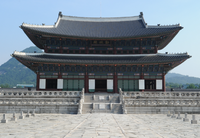Okjeo
| Okjeo | |
| Hangul | 옥저 |
|---|---|
| Hanja | 沃沮 |
| Revised Romanization | Okjeo |
| McCune–Reischauer | Okchŏ |
| History of Korea | |
|---|---|
 | |
| 8000 BC–1500 BC | |
| * Jeulmun | |
| Bronze Age | 1500 BC–300 BC |
| * Mumun | |
| * Liaoning dagger |
| Okjeo | |
| Hangul | 옥저 |
|---|---|
| Hanja | 沃沮 |
| Revised Romanization | Okjeo |
| McCune–Reischauer | Okchŏ |
Part of a series on the |
|
|---|---|
| History of Korea | |
 | |
|
Neolithic | 8000 BC–1500 BC |
| * Jeulmun | |
| Bronze Age | 1500 BC–300 BC |
| * Mumun | |
| * Liaoning dagger |
| Goryeo | 918–1392 |
| Tamna (Vassal of Goryeo) | 938–1105 |
| Heungyo | 1029–1030 |
| Joseon | 1392–1897 |
| Korean Empire | 1897–1910 |
| Japanese occupation | 1910–1945 |
| Provisional Government | 1919–1948 |
| People's Republic of Korea | 1945 |
| Military governments | 1945–1948 |
| North-South division | 1945–present |
| * North | 1948–present |
| * South | 1948–present |
Okjeo (Korean pronunciation: [ok̚.t͈ɕʌ]) was an ancient Korean tribal state which arose in the northern Korean peninsula from perhaps the 2nd century BCE to the 5th century CE.
Dong-okjeo (Eastern Okjeo) occupied roughly the area of the Hamgyŏng provinces of North Korea, and Buk-okjeo (Northern Okjeo) occupied the Duman River region.
Dong-okjeo was often simply called Okjeo, while Buk-okjeo was also sometimes referred to as Chiguru (置溝婁, 치구루) or Guru (구루),[1] the latter name being also applied to Goguryeo. Okjeo bordered the other minor state of Dongye on the south, and shared a similar fate.

In its early history, Okjeo oscillated between domination by the Chinese commanderies and by Goguryeo.
In early 5th century, Okjeo was completely conquered by Gwanggaeto the Great of Goguryeo.
Eastern Okjeo is located to the east of the great mountains of Gaema in Goguryeo; its people make their settlements on the shore of the great sea. In shape their land is narrow in the northeast and long in the southwest, where it is perhaps a thousand li. It is contiguous on the north with Yilou and Buyeo, and on the south with Yemaek. Its households number five thousand. They have no supreme Ruler, each village having its own hereditary chief. Their language has broad similarity with that of Goguryeo, though at times there are small differences... Their land is fair and fertile, facing the sea with its back to the mountains. It is well suited to the cultivation of the five grains, and they are good at tilling and planting. The people are simple and direct, strong and brave. Having few oxen and horses, they are adept at fighting on foot, wielding spears.
Samguk Sagi
Knowledge of Okjeo culture is fragmentary. As with the Dongye and Okjeo's language, food, clothing, architecture, and customs were similar to that of Goguryeo. The Okjeo people practised arranged marriage by which the child-bride lived with the child-groom's family until adulthood, and they interred the dead of a family in a single coffin.
| Authority control databases: National |
|---|